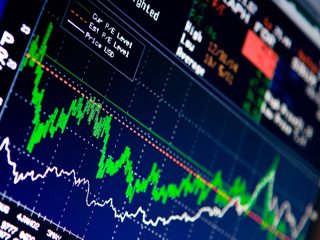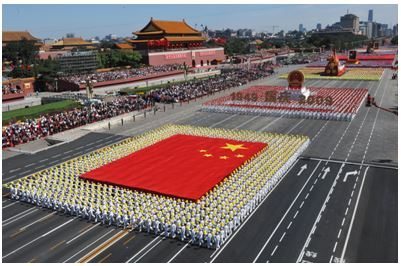As a potentially profitable opportunity presents itself, John will send you an alert with specific trade information as to what should be bought, when to buy it, and at what price. Read more
As a potentially profitable opportunity presents itself, John will send you an alert with specific trade information as to what should be bought, when to buy it, and at what price. This is your chance to ?look over? John Thomas? shoulder as he gives you unparalleled insight on major world financial trends BEFORE they happen. Read more
Global Market Comments
April 25, 2013
Fiat Lux
Featured Trade:
(MAY 8 LAS VEGAS STRATEGY LUNCHEON),
(SELL IN MAY HAS ALREADY STARTED),
(SPY), (IWM), (TLT), (TBT), (GLD), (SLV), (USO), (UNG),
(CHINA?S VIEW OF CHINA), (FXI), (EEM)
SPDR S&P 500 (SPY)
iShares Russell 2000 Index (IWM)
iShares Barclays 20+ Year Treas Bond (TLT)
ProShares UltraShort 20+ Year Treasury (TBT)
SPDR Gold Shares (GLD)
iShares Silver Trust (SLV)
United States Oil (USO)
United States Natural Gas (UNG)
iShares FTSE China 25 Index Fund (FXI)
iShares MSCI Emerging Markets Index (EEM)
Come join me for lunch at the Mad Hedge Fund Trader?s Global Strategy Update, which I will be conducting in Las Vegas, Nevada on Wednesday, May 8, 2013. An excellent meal will be followed by a wide-ranging discussion and an extended question and answer period.
I?ll be giving you my up to date view on stocks, bonds, currencies, commodities, precious metals, and real estate. I will also explain how I have been able to deliver a blowout 40% return since the November, 2012 market bottom. And to keep you in suspense, I?ll be throwing a few surprises out there too. Tickets are available for $179.
I?ll be arriving at 11:00 and leaving late in case anyone wants to have a one on one discussion, or just sit around and chew the fat about the financial markets. The PowerPoint presentation will be emailed to you three days before the event.
The lunch will be held at a major Las Vegas hotel on the Strip, the details will be emailed with your purchase confirmation. Please make your own hotel reservations, as business there is booming.
I look forward to meeting you, and thank you for supporting my research. To purchase tickets for the luncheons, please go to my online store.
You don?t have to wait until May for the next correction in the stock market, which is only four trading days away. Take a look at the charts below prepared by my good friends, Arthur Hill and John Murphy at Stockcharts.com, and you?ll see it has already started. In fact, it might be almost over.
Only 42% of stocks listed on the New York Stock Exchange are now above their 50-day moving averages, down from the 90% peak at the end of January. That suggests we are already well into bear market territory. The downturn has been lead by materials, technology, energy, and industrials.
Look at the charts for the S&P 500 (SPY) and the Dow. We are clearly on target to match the previous all time highs in the next few days, possibly during the month end liquidity surge. That?s where potential double tops come into play. If I am right, then we could be in for a 5%-10% pullback. If I am wrong, then we are in for a flat line for a month before we resume the upward path.
So I am modifying my trading strategy that has been wildly successful for the past six months, delivering to you a 45% performance gain off the bottom. To use all of my favorite sailing metaphors, I?ll be battening down the hatches, clearing the decks, reefing the sheets, and preparing for a squall.
Here are the following course adjustments I recommend for a tougher market:
1) Cut your book in half and maintain a 50% cash position to take advantage of the unanticipated opportunities that will almost certainly come. You can?t buy bottoms if you lost all of your money on the downslide.
2) Shorten your maturities. Instead of betting the ranch by going out two or three months, limit option positions to the front month. There is no crueler existence than managing a long dated option position that is going against you.
3) Pigs get fed, but hogs get slaughtered. Instead of running positions into expiration, go for quicker, smaller profits. Instead of keeping the entire profit, settle for half or two thirds. Market volatility is so low that it is not worth hanging on for the final two weeks just to capture the last few basis points. This shortens the time that surprises or black swans can happen. Use time as capital. As I have so magnificently shown this year, you get a much higher score hitting 40 singles than a couple of home runs (hint for foreigners: our baseball season has just started).
4) Get yourself some short exposure for the inevitable shakeout. I recommend put spreads in the Russell 2000 (IWM), which always falls the fastest in down markets. But go at least 5% in-the-money to give yourself a safety margin income in case this thing keeps clawing its way up.
5) Avoid positions that have worked well for the past half-year, because this is where traders will rush to take profits and ?de-risk? their books first. This includes long positions in consumer staples, pharmaceuticals, utilities, and transportation, and short positions in commodities (CU), oil (USO), and precious metals (GLD) (SLV).
6) Get out of your bond shorts. It?s amazing to me that ten-year yields (TLT) have fallen to a parsimonious 1.70%, while stocks have rallied. But then, it has been an amazing life. This is rare in the rich tapestry of financial markets and usually presages trouble. It can only mean that the smart money is positioning itself cautiously in anticipation of a dump in stocks. If that is the case, the May correction could take ten year yields down to 1.50%, and bond prices though the roof. Use the month end ?RISK ON? surge to take profits on the (TBT).
There is an alternative explanation for all of this. The correction is already done and we are about to launch into a new bull leg. The selloff has been masked by a rotation within the broader indexes. Take another look at the chart of stocks above their 50-day moving averages. We have spent three months falling from 90% to 42%. Historically, it bottoms at 20%. The last time this happened was at the end of November and early June. Remember what happened after that?
If that is the case, we are already two thirds of the way through the spring correction, and on the eve of another 5%-10% leg up in stocks and other risk assets. It is what investors are least expecting; therefore, it cannot be ruled out. As my in-house strategist, Sherlock Holmes, used to say, ?Eliminate the obvious, and consider all other possibilities.?
 Meet My New Strategist
Meet My New Strategist
I ran into Minxin Pei, a scholar at the Carnegie Endowment for International Peace who imparted to me some iconoclastic, out of consensus views on China?s position in the world today.
He thinks that power is not shifting from West to East; Asia is just lifting itself off the mat, with per capita GDP at $5,800, compared to $48,000 in the US. We are simply moving from a unipolar to a multipolar world. China is not going to dominate the world, or even Asia, where there is a long history of regional rivalries and wars.
China can?t even control China, where recessions lead to revolutions, and 30% of the country, Tibet and the Uighurs, want to secede. China?s military is entirely devoted to controlling its own people, which make US concerns about their recent build up laughable.
All of Asia?s progress, to date, has been built on selling to the US market. Take us out, and they?re nowhere. With enormous resource, environmental, and demographic challenges constraining growth, Asia is not replacing the US anytime soon.
There is no miracle form of Asian capitalism; impoverished, younger populations are simply forced to save more, because there is no social safety net. Try filing a Chinese individual tax return, where a maximum rate of 40% kicks in at an income of $35,000 a year, with no deductions, and there is no social security or Medicare in return. Ever heard of a Chinese unemployment office or jobs program?
Nor are benevolent dictatorships the answer, with the despots in Burma, Cambodia, North Korea, and Laos thoroughly trashing their countries. The press often touts the 600,000 engineers that China graduates, joined by 350,000 in India. In fact, 90% of these are only educated to a trade school standard. Asia has just one world-class school, the University of Tokyo.
As much as we Americans despise ourselves and wallow in our failures, Asians see us as a bright, shining example for the world. After all, it was our open trade policies and innovation that lifted them out of poverty and destitution. Walk the streets of China, as I have done for nearly four decades, and you feel this vibrating from everything around you. I?ll consider what Minxin Pei said next time I contemplate going back into the (FXI) and (EEM).
 China: Not All it?s Cracked Up to Be
China: Not All it?s Cracked Up to Be
Global Market Comments
April 24, 2013
Fiat Lux
Featured Trade:
(JULY 2 NEW YORK STRATEGY LUNCHEON),
(THINGS ARE HEATING UP IN MEXICO),
(EWW), (UMX), (BSMX), (EEM),
(BUDGET CUTS HOT THE WILD ANIMAL MARKET)
iShares MSCI Mexico Capped Invstbl Mkt (EWW)
ProShares Ultra MSCI Mexico Cppd IMI (UMX)
Grupo Financiero Santander S.A.B. de C.V. (BSMX)
iShares MSCI Emerging Markets Index (EEM)
Come join me for lunch for the Mad Hedge Fund Trader?s Global Strategy Seminar, which I will be conducting in New York, NY on Tuesday, July 2, 2013. An excellent three-course lunch will be provided. A PowerPoint presentation will be followed by an extended question and answer period.
I?ll be giving you my up to date view on stocks, bonds, foreign currencies, commodities, precious metals, and real estate. And to keep you in suspense, I?ll be throwing a few surprises out there too. Enough charts, tables, graphs, and statistics will be thrown at you to keep your ears ringing for a week. Tickets are available for $209.
The formal luncheon will run from 12:00 to 2:00 PM. I?ll be arriving an hour early and leaving late in case anyone wants to have a one on one discussion, or just sit around and chew the fat about the financial markets.
The event will be held at a prestigious private club on Central Park South, the details of which will be emailed to you with your purchase confirmation.
I look forward to meeting you, and thank you for supporting my research. To purchase tickets for the luncheons, please go to my online store.
I have fond memories traveling around northern Mexico during the 1950?s. My grandfather used to drive us across the border into Baja in his pickup truck, the back loaded with camping equipment, water, fishing poles, rifles, and shotguns. There was no border control.
To eat, we only had to wait for the tide to go out on the Sea of Cortez, uncovering a banquet of fresh mussels, oysters, and abalone. Eventually, my Spanish got pretty good, especially when it came to fixing cars. When we encountered rare collections of palm frond huts we would lounge around on the beach eating all the tacos we wanted for 5 cents each.
There wasn?t a hotel on the entire peninsula; and the desert was frequented with armed banditos. If any stranger approached, we fired a shot over their heads, at a considerable distance, to convince them to seek easier pickings elsewhere. It was still the Wild West down there, and we didn?t go there to socialize.
As much I loved the land of Montezuma and Pancho Villa, I have never invested a penny in the country. Oil has been the bread and butter for the land south of the border for nearly a century, accounting for the largest share of the government?s revenues. But its main Cantarell field is nearly tapped out, suffering from declining production for years.
There was a decade long drug war in which 40,000 died. It seemed, for a while, that the narcoterrorists would win. Mexico City became the kidnapping capital of the world. In the emerging market space, there always seemed to be better opportunities elsewhere. On top of that, the country has a long history of expropriating the property of gringos. So for decades I limited my interest in Mexico to beer, tequila, and tacos.
However, in recent months, the jungle telegraph in the hedge fund community has been buzzing about this once unloved country. I thought I?d take a closer look. It turns out that a few things have changed over the last 60 years.
First, oil. Yes, Cantarell is just about done. But much of Mexico?s subterranean geology is similar to that of the US. That means that the fracking boom, whereby untold quantities of cheap natural gas have suddenly become available, is spilling over into Mexico as well.
And guess what? They don?t face the environmental backlash or the permitting restrictions that American drillers must endure. As a result, Mexican energy production is taking off once again, with exports to Asia a major target. Energy infrastructure investment will become a significant economic driver in the decades to come. This is hugely positive for both the Mexican economy and the peso.
When China first burst on the international scene during the early nineties, using its cheap labor to replace much of he world?s manufacturing capacity, it was Mexico that took the big hit. Much of their low-end production, such as in textiles, decamped for the Middle Kingdom, leaving hundreds of thousands jobless.
The new ?onshoring? trend that is creating a blue collar jobs renaissance in the US is gaining speed in Mexico too. While Chinese wages have been skyrocketing at a 20% annual rate, they have been relatively stable in Mexico.
You see this first and foremost with goods that pose logistical challenges, such as anything involving significant transportation costs. You probably don?t know this, but that big screen high definition TV dominating your living room, which used to be assembled near Shenzhen, is now put together a couple of miles inside the border with Texas. From there, they can be easily and cheaply shipped by rail or truck to any point in the US.
Mexico?s $1.18 trillion GDP ranked 14th in the world in 2012. It stood 11th in population with 112 million. Its per capita income of $10,247 comes in at 66th. The energy boom is likely to boost economic growth from the current 4% annual rate. A strong peso should cause its inflation rate to fall from the present 3.6%. I don?t have to tell you that this is a dream come true scenario for investors. Many analysts expect Mexico to join the world?s top ten economies by 2020.
The one problem Mexico has is that it is tarred with the emerging market brush (EEM), one of the world?s poorest performing asset classes this year. At least Mexico has flat lined instead of crashed, as others have. You may have to wait for the Chinese tide to lift all boats for this unloved sector to move back into the spotlight. That said, emerging markets could be the great rotation play in the last quarter of 2013.
There are a number of American Depository Receipts (ADR?s) issued by Mexican multinationals listed on the NYSE, such as those for Grupo Financiero Santander (BSMX), one of the country?s largest banks. If you are really brave, you can open a peso denominated account with a broker in Mexico City and invest in stocks there directly. The easiest way to put money into the country is through the Mexico iShares ETF (EWW). Or you can trade the leveraged long ETF, the ProShares Ultra MSCI Mexico Investable Market ETF (UMX).
I went down to Cabo San Lucas a few years ago for some Marlin fishing and to see what had changed. A ten-mile string of hotels lined the beach with names like the Trump Tower and the Four Seasons. The price of tacos had risen from 5 cents to $2. Free spending European tourists crowded bars like the Cabo Wabo, where they strung you up by your feet to see if you could drink tequila shots upside down.
Rather than dine at one of the many overpriced and crowded restaurants, I got in the car and drove north. I stopped at a small out of the way cove, and as the tide went out, I ate my fill of shellfish. Grandpa would have been proud.
 Mexican Pesos to the Dollar
Mexican Pesos to the Dollar
 Gotta Love Those Mexican Shares
Gotta Love Those Mexican Shares
Legal Disclaimer
There is a very high degree of risk involved in trading. Past results are not indicative of future returns. MadHedgeFundTrader.com and all individuals affiliated with this site assume no responsibilities for your trading and investment results. The indicators, strategies, columns, articles and all other features are for educational purposes only and should not be construed as investment advice. Information for futures trading observations are obtained from sources believed to be reliable, but we do not warrant its completeness or accuracy, or warrant any results from the use of the information. Your use of the trading observations is entirely at your own risk and it is your sole responsibility to evaluate the accuracy, completeness and usefulness of the information. You must assess the risk of any trade with your broker and make your own independent decisions regarding any securities mentioned herein. Affiliates of MadHedgeFundTrader.com may have a position or effect transactions in the securities described herein (or options thereon) and/or otherwise employ trading strategies that may be consistent or inconsistent with the provided strategies.

























